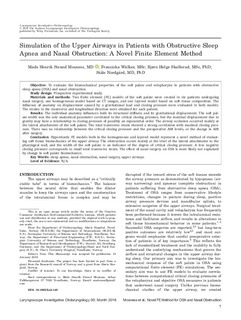| dc.contributor.author | Moxness, Mads Henrik Strand | |
| dc.contributor.author | Wülker, Franziska Sophie | |
| dc.contributor.author | Skallerud, Bjørn Helge | |
| dc.contributor.author | Nordgård, Ståle | |
| dc.date.accessioned | 2018-02-26T08:58:56Z | |
| dc.date.available | 2018-02-26T08:58:56Z | |
| dc.date.created | 2018-02-22T21:17:52Z | |
| dc.date.issued | 2018 | |
| dc.identifier.issn | 2378-8038 | |
| dc.identifier.uri | http://hdl.handle.net/11250/2486854 | |
| dc.description.abstract | Objective
To evaluate the biomechanical properties of the soft palate and velopharynx in patients with obstructive sleep apnea (OSA) and nasal obstruction.
Study design
Prospective experimental study.
Materials and methods
Two finite element (FE) models of the soft palate were created in six patients undergoing nasal surgery, one homogeneous model based on CT images, and one layered model based on soft tissue composition. The influence of anatomy on displacement caused by a gravitational load and closing pressure were evaluated in both models. The strains in the transverse and longitudinal direction were obtained for each patient.
Results
The individual anatomy influences both its structural stiffness and its gravitational displacement. The soft palate width was the sole anatomical parameter correlated to the critical closing pressure, but the maximal displacement due to gravity may have a relationship to closing pressure of possibly an exponential order. The airway occlusion occurred mainly at the lateral attachments of the soft palate. The total transverse strain showed a strong correlation with maximal closing pressure. There was no relationship between the critical closing pressure and the preoperative AHI levels, or the change in AHI after surgery.
Conclusion
Hyperelastic FE models both in the homogeneous and layered model represent a novel method of evaluating soft tissue biomechanics of the upper airway. The obstruction occurs mainly at the level of the lateral attachments to the pharyngeal wall, and the width of the soft palate is an indicator of the degree of critical closing pressure. A less negative closing pressure corresponds to small total transverse strain. The effect of nasal surgery on OSA is most likely not explained by change in soft palate biomechanics.
Level of Evidence
N/A. | nb_NO |
| dc.language.iso | eng | nb_NO |
| dc.publisher | Wiley | nb_NO |
| dc.rights | Attribution-NonCommercial-NoDerivatives 4.0 Internasjonal | * |
| dc.rights.uri | http://creativecommons.org/licenses/by-nc-nd/4.0/deed.no | * |
| dc.title | Simulation of the upper airways in patients with obstructive sleep apnea and nasal obstruction: A novel finite element method | nb_NO |
| dc.type | Journal article | nb_NO |
| dc.type | Peer reviewed | nb_NO |
| dc.description.version | publishedVersion | nb_NO |
| dc.source.journal | Laryngoscope Investigative Otolaryngology | nb_NO |
| dc.identifier.doi | 10.1002/lio2.140 | |
| dc.identifier.cristin | 1568064 | |
| dc.description.localcode | © 2018 The Authors Laryngoscope Investigative Otolaryngology published by Wiley Periodicals, Inc. on behalf of The Triological Society This is an open access article under the terms of the Creative Commons Attribution-NonCommercial-NoDerivs License. | nb_NO |
| cristin.unitcode | 194,65,30,0 | |
| cristin.unitcode | 194,64,45,0 | |
| cristin.unitname | Institutt for nevromedisin og bevegelsesvitenskap | |
| cristin.unitname | Institutt for konstruksjonsteknikk | |
| cristin.ispublished | true | |
| cristin.fulltext | original | |
| cristin.qualitycode | 1 | |

